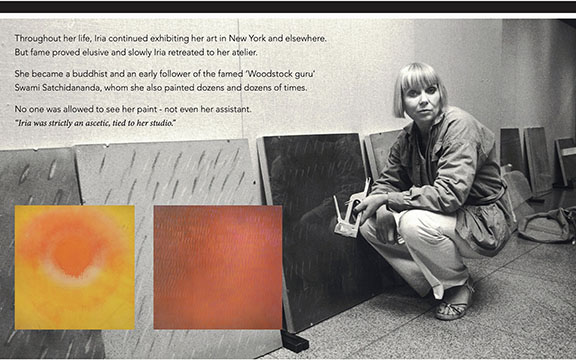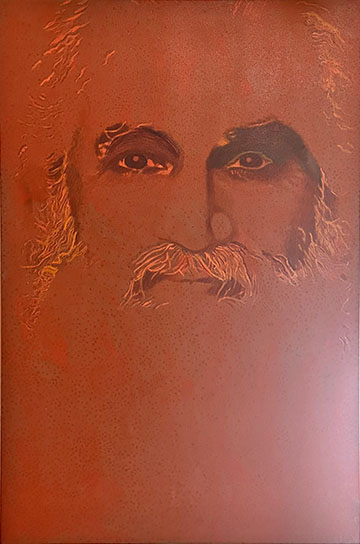
Iria Leino at work in her SoHo loft. Photo courtesy of iriathefilm.com
The Finnish-born artist Iria Leino is known not only for her expansive body of abstract work but also for her deep spiritual devotion, which played a central role in her artistic development. Throughout her life, she found inspiration in a rich spiritual practice and, significantly, through her relationship with Swami Satchidananda and Integral Yoga. This connection brought new depth to her work, imbuing her art with the meditative and introspective qualities for which it became known.
From Finland to the World of Art and Fashion
Born in Helsinki, Iria Leino’s early passion for drawing and painting blossomed as she grew, and her artistic abilities took her far beyond her Finnish roots. Initially, she found herself in the world of fashion as a successful model in Paris, a city where creativity and art flourished after World War II. Despite her success in the modeling world, she felt a strong pull toward a more meaningful life path—one focused on artistic creation and spirituality.
Eventually, Iria left her modeling career behind, returning to her artistic roots and immersing herself in painting. Her life became a balance of devotion to art and a search for inner meaning, themes that became increasingly central as her work developed.
Spiritual Transformation and Embrace of Yoga
As Iria’s life took a more introspective turn, spirituality became a defining aspect of her work and existence. She first delved into Buddhist practices, which influenced both her spiritual outlook and her art. Elephants—sacred in Buddhism—were the focus of her well-known “Elephant Series,” evoking wisdom, strength, and the sacredness of life.
A transformative moment in her spiritual journey came in the early 1970s when she connected with Swami Satchidananda, the founder of Integral Yoga. He was a renowned spiritual teacher who had brought the teachings of classical Yoga to the West, focusing on a holistic approach to life that balanced physical health, mental peace, and spiritual growth. Iria, drawn to his teachings, affectionately referred to him as “Gurudev,” and his teachings provided a deep sense of spiritual grounding and direction for her life and art.
Under Gurudev’s guidance, Iria found a path that combined spiritual discipline, self-awareness, and creativity. Yoga was not just a practice of physical postures for her; it was a way of being, a framework through which she could channel her artistic expression into a form of meditation and spiritual devotion. Her connection to Swami Satchidananda also played a role in her healing, as she credited his teachings with helping her overcome struggles with bulimia.
Art as a Meditative Journey
For Iria, painting was far more than a visual endeavor; it was an expression of her inner spiritual journey. Her work often evolved in a meditative space, influenced by hymns, chants, and mantras that arose spontaneously while she painted. She was deeply moved by the belief that art could become a channel for Divine Consciousness, a concept strongly echoed in her Guru’s teachings.
Iria embraced the idea that her artistic practice could serve as an active form of meditation, bringing the experience of the divine into every brushstroke. Like fellow artist Peter Max—also a student of Yoga inspired by Swami Satchidananda—she sought to allow the Cosmic Consciousness to flow through her, letting go of ego and letting the spiritual essence guide her creative process.
This practice of creating art as meditation is particularly evident in her “Buddhist Rain Series.” With its thousands of layered strokes, this series captures an ethereal and contemplative essence, as if each line and color represented a thought, a breath, or a spiritual insight that flowed directly from her consciousness onto the canvas.
A Life of Devotion and Solitude
In the years that followed, Iria’s devotion to spirituality and art led her to live a life of simplicity and solitude. She was not focused on recognition or external success but rather on the internal process of creation and spiritual discovery. She often withdrew from public life, spending much of her time in her SoHo loft, where she lived and worked in a space that served as her sanctuary and studio.
Painting was a sacred practice for Iria—a sadhana that demanded full attention and devotion. This inner focus became central to her life. Her artwork became a living expression of her spiritual practice, offering a window into the transcendence and beauty that can arise from deep meditation and contemplation.
Iria’s spiritual journey also impacted her choice of themes. For example, her later works, such as “The Growing Series,” were inspired by the meditative focus on a simple houseplant, the Lucky Bamboo. She viewed this daily practice of focusing on the plant as a way to cultivate spiritual energy and align with the natural flow of life. Her reverence for nature and life as a reflection of spiritual truth shone through in each piece, inviting viewers to experience the deeper realities she aimed to reveal.

Photo: Iria’s large painting of Gurudev, made of tiny dots, that she gifted to the IYI, where it still hangs.
The Solitary Practice of an Artist-Yogi
While she found herself increasingly isolated, this isolation was a conscious decision that allowed Iria to cultivate her spirituality and art without distraction. Her retreat into her own world was not simply a withdrawal but a profound commitment to living a life aligned with spiritual values. She limited her interactions with the outside world, instead dedicating herself to Yoga, meditation, and painting. She rarely ventured out and when she did it was usually to attend a talk by Gurudev or take a class at the Integral Yoga Institute.
Swami Satchidananda’s teachings emphasized that the pursuit of spiritual realization is often accompanied by a letting go of worldly attachments and distractions—a principle Iria embodied. By minimizing her possessions and focusing her energy on her art, she lived a life that resonated with the yogic ideal of simplicity, balance, and inner peace.
Despite her reclusive lifestyle, Iria remained deeply connected to the world around her through her political activism and passion for social change, particularly in advocating for women’s representation in the art world. Her spirituality and devotion to Gurudev’s teachings only deepened her dedication to expressing truth and justice through her work.
A Legacy of Spiritual Artistry
Iria Leino’s life as an artist was not just about creating visual beauty but about embodying and expressing a spiritual journey. Her art, guided by the principles of Yoga and the teachings of Integral Yoga, transcended the mere act of painting. It became a practice of revealing the divine within, exploring themes of oneness, harmony, and the interconnectedness of all life.
Her art remains a vibrant reflection of the deep spirituality that flowed through her. It continues to inspire viewers to connect with their own spiritual journeys, encouraging a sense of peace and introspection. Iria’s legacy, as an artist who saw her craft as a meditative offering, invites others to experience art not just as a visual experience but as a path to the sacred.
Through her life’s work and spiritual devotion, Iria demonstrated how art, Yoga, and spirituality can form a harmonious whole—each aspect enriching the other, and together creating a life of profound beauty, depth, and grace.
Though Iria Leino passed away in 2022 she and her work are once again garnering attention. Several articles about her in the New York Times and W magazine, among others, have recently been published and a documentary is about her is in pre-production. Through October 19th, Harper’s Gallery in Chelsea, New York is hosting an exhibition of some of her work.
About the Author:
 Swami Premananda, Ph.D. is a senior disciple of Sri Gurudev Swami Satchidananda and served as his personal and traveling assistant for 24 years. She serves as editor of Integral Yoga Magazine, Integral Yoga Publications; senior archivist for Integral Yoga Archives; and director of the Office of Sri Gurudev and His Legacy.
Swami Premananda, Ph.D. is a senior disciple of Sri Gurudev Swami Satchidananda and served as his personal and traveling assistant for 24 years. She serves as editor of Integral Yoga Magazine, Integral Yoga Publications; senior archivist for Integral Yoga Archives; and director of the Office of Sri Gurudev and His Legacy.

